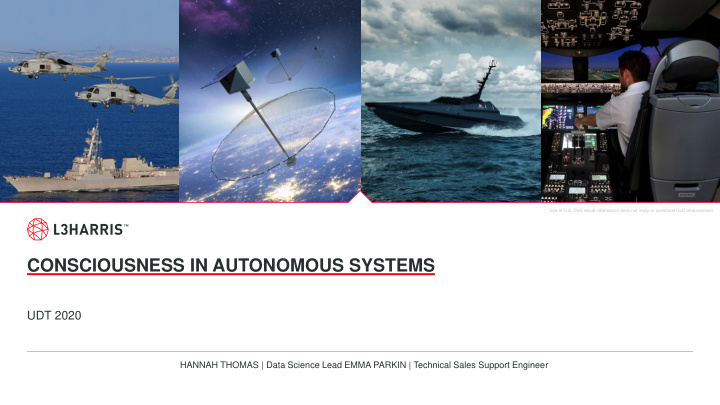



Use of U.S. DoD visual information does not imply or constitute DoD endorsement CONSCIOUSNESS IN AUTONOMOUS SYSTEMS UDT 2020 HANNAH THOMAS | Data Science Lead EMMA PARKIN | Technical Sales Support Engineer
Definition of Consciousness “the state of being aware of and responsive to one's surroundings” L3HARRIS PRESENTATION TITLE (USE INSERT > HEADER & FOOTER TO EDIT FOR ALL SLIDES) Proprietary Information 2
The Need for Consciousness in Autonomous Systems • Modern processing power makes consciousness in autonomous systems is practical today • Current codes of practice expect autonomous vessels (ASVs) to behave like humans • Even if maritime infrastructure were better developed for ASVs, consciousness would still be required for emergency response • Machine reactions are much faster than humans • It may be critical for ASVs to make conscious decisions without supervision in some scenarios • Whilst it remains to be seen how human-machine interaction, maritime infrastructure, regulations and resources will evolve, and the level of consciousness ultimately required in autonomous vessels is unknown, it is clear that some “basic” level of consciousness certainly is required. L3HARRIS PRESENTATION TITLE (USE INSERT > HEADER & FOOTER TO EDIT FOR ALL SLIDES) Proprietary Information 3
Achieving Consciousness in Autonomy Today Give way Sailing vessel on collision course Sailing vessel Track on collision course ahead Images as Raw radar pixel arrays returns Formally a data science problem L3HARRIS PRESENTATION TITLE (USE INSERT > HEADER & FOOTER TO EDIT FOR ALL SLIDES) Proprietary Information 4
Receiving Data Data are facts collected from on-board sensors and other sources, which are unorganised and unprocessed LIDAR (image to come) AIS (image to come) RADAR MAPS/CHARTS CAMERAS EXTERNAL DATA FEEDS (e.g. satellite AIS, web-based feeds) L3HARRIS PRESENTATION TITLE (USE INSERT > HEADER & FOOTER TO EDIT FOR ALL SLIDES) Proprietary Information 5
Data to Information Information is data that has been processed in a way that provides useful descriptions for understanding the surrounding environment SEA STATE ESTIMATION IMAGE RECOGNITION RADAR CLASSIFICATION L3HARRIS PRESENTATION TITLE (USE INSERT > HEADER & FOOTER TO EDIT FOR ALL SLIDES) Proprietary Information 6
Information to Situational Awareness Situational awareness is the result of combining and connecting information and using it to understand the surrounding environment RISK LANDSCAPE INTENT RECOGNITION SENSOR FUSION L3HARRIS PRESENTATION TITLE (USE INSERT > HEADER & FOOTER TO EDIT FOR ALL SLIDES) Proprietary Information 7
Situational Awareness to Decision-Making Decision making is the process of applying situational awareness to take action L3HARRIS PRESENTATION TITLE (USE INSERT > HEADER & FOOTER TO EDIT FOR ALL SLIDES) Proprietary Information 8
Challenges to developing Conscious Autonomous Systems • Data Availability • Lack of standard services as of yet for autonomy • Lack of standard sensors as of yet for autonomy • Future of Charts • Need for Learning • Requires big-scale testing • Requires patience • Requires trust L3HARRIS PRESENTATION TITLE (USE INSERT > HEADER & FOOTER TO EDIT FOR ALL SLIDES) Proprietary Information 9
Conclusion • No doubt achieving consciousness is possible • Remains to be seen what level of consciousness will ultimately be “enough” as ASVs grow in popularity • In order for the current challenges to be overcome, a change in common practice and mind sets is required L3HARRIS PRESENTATION TITLE (USE INSERT > HEADER & FOOTER TO EDIT FOR ALL SLIDES) Proprietary Information 10
Recommend
More recommend